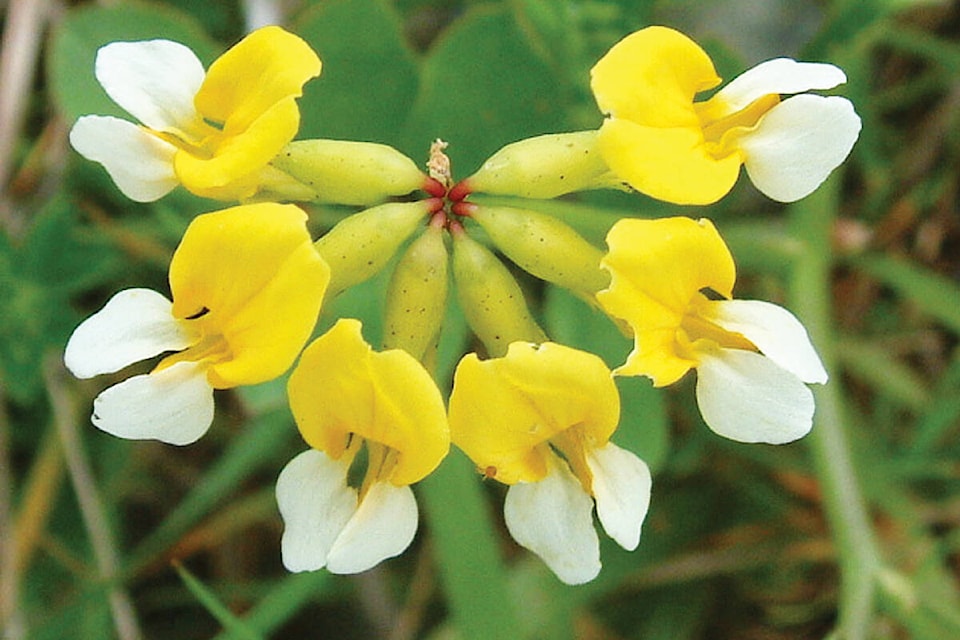The notion of development has intensified efforts to protect Nanaimo’s ecologically sensitive Harewood Plains, and city council will make a formal request for help from the federal and provincial governments.
At a meeting Monday, March 4, Coun. Paul Manly put forward motions to ask that the province and feds work with the city, Regional District of Nanaimo, Snuneymuxw First Nation, Nanaimo Area Land Trust to protect the areas within the Harewood Plains. The plains are a habitat for an estimated 85 to 98 per cent of Canada’s total remaining population of the hosackia pinnata plant – formerly known as lotus pinnatus – an endangered species under Canada’s Species at Risk Act and the City of Nanaimo’s official floral emblem.
“The plant is commonly known as bog birds-foot trefoil and there are many reasons to protect the Harewood Plains … and there are other rare and endangered plants present on the plains,” said Paul Chapman, Nanaimo Area Land Trust executive director, in his presentation to council.
The balance of hosackia pinnata’s range in Canada also lies within the Nanaimo region.
The Harewood Plains is an area in southwest Nanaimo near the Nanaimo Parkway, stretching from Lotus Pinnatus Way, Palomino Place and Western Acres Road at its western boundary, to McKeown Way to the east. The area includes Lotus Pinnatus Park and an area protected by an existing covenant, but the city has received subdivision and development permit applications proposing a 10-lot development for a privately owned section.
“The city plan includes this property within the urban containment boundary and designates it as a suburban neighbourhood, keeping in mind that much of it is already protected,” said Nanaimo Mayor Leonard Krog, reading a report about the property from city staff.
The property is subject to development restrictions for its environmentally sensitive areas, wildfire hazards, and steep slope.
Krog said council has received about 500 e-mails from the public regarding the development proposal.
Chapman said the Harewood Plains are the only place in Canada where the plants are thriving, but the parks and covenant areas don’t cover the majority of the critical and “exceedingly rare” habitat necessary to support the plants. The additional areas required include water catchment areas extending beyond the park and city boundaries into Regional District of Nanaimo land.
Hosackia pinnata habitat also exists on the U.S. west coast, Chapman said, but Nanaimo is the northernmost point of its range and he stressed that nothing in Canada compares to the population size and viability of Nanaimo’s hosackia pinnatus population.
“This is it in B.C. This is it in Canada. This is unique to Nanaimo. There are no other Harewood Plains. This is it,” he said.
Manly asked about other at-risk plant species in the Harewood Plains and if the large areas of camas that grows there were cultivated by Snuneymuxw First Nation. Camas, member of the asparagus family, was a food source cultivated by First Nations peoples.
Chapman listed Carex Tumulicula – a type of grass – and dense-spike primrose as at-risk, as well as some insect species.
“I’m not going to presume to answer on behalf of Snuneymuxw, but … camas doesn’t spread easily without intervention, so when you come across large swaths of camas it invariably means that it has been managed, over time, as a food source,” Chapman said.
Coun. Hilary Eastmure asked about installing signs to show Lotus Pinnatus Park’s boundaries and barriers to prevent off-road vehicles from damaging the habitat. Richard Harding, general manager of community services, said he was surprised to learn that hadn’t been done, and would make sure it was on a to-do list.
“The other portion, which is the covenant area, that’s still private property, so we can’t do that portion,” Harding said.
Hunter Jarratt, restoration consultant with Kiki Nursery, described the Harewood Plains as the “beating heart of our Garry oak ecosystems left in Canada.”
“Nowhere else have I seen such prolific abundant blooms of native wildflowers,” Jarratt said. “The rare vernal pools and ephemeral wetlands at Harewood Plains, which are often overlooked and not protected or even acknowledged by the Canadian wetland classification system, are home to species at risk of extinction.”
The motion passed unanimously.
READ ALSO: Stewardship group wants to protect Harewood Plains, home of Nanaimo’s official flower
